M. Thomas Apple's Blog, page 23
February 1, 2023
“Green comet” buzzing Earth “Wednesday”
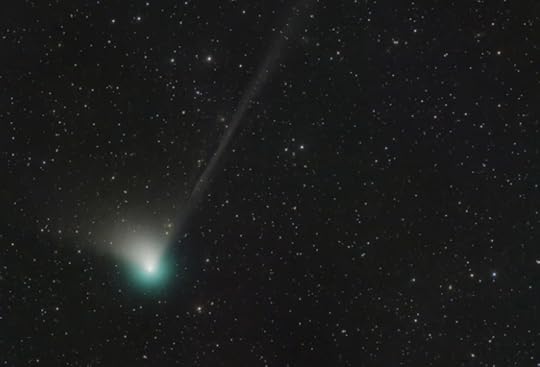
A comet from the outer solar system is set to buzz Earth on Wednesday and skywatchers have a chance to glimpse the celestial object as it journeys through our cosmic neighborhood for the first time in 50,000 years.
https://www.nbcnews.com/science/space/green-comet-approach-flyby-earth-rcna65202
If by “Wednesday” you mean “Wednesday in North America. There is no “on Wednesday” worldwide, thanks.
Observers in the Northern Hemisphere should look northeast just after the Moon sets and before dawn. You should be able to see it with a good pair of binoculars.
The last time Comet C/2022 E3 (ZTF) made a visit, Homo sapiens still had Neanderthal neighbors, so this is your one and only! 
January 29, 2023
“It clearly was not Cowboy Bebop”

It started with a scene in a casino, which made it very tough for me to continue. I stopped there and so only saw that opening scene.
https://soranews24.com/2023/01/28/cowboy-bebop-anime-creator-was-disappointed-with-the-netflix-version-from-the-first-scene-he-saw/
Well, I managed to watch the first two episodes, but I really couldn’t continue after that.
Watanabe is right. Netflix screwed up by doing what all US-based companies do when they try to make scifi: they focus on the violence and forget about the ambiance.
But as he says at the end of the interview, “The value of the original anime is somehow far higher now.”
(Read the original interview in its entirety here, if you can stomach the political pop-ups.)
January 26, 2023
“Don’t worry,” they said, “the size of a truck,” they said…

An asteroid is on its way to Earth, but don’t worry – the end is here Not here. The asteroid, named 2023 BU, is about the size of a van and is expected to miss our planet during Thursday’s flyby. However, according to a NASA scientist, it will be “one of the closest approaches of a known near-Earth object ever recorded.”
https://newsbeezer.com/germanyeng/a-truck-sized-asteroid-will-come-extraordinarily-close-to-earth-tomorrow/
This thing is coming closer than even some satellites, but it’s still small enough for most of it to burn up in the atmosphere.
Most of it.
Yikes.
January 25, 2023
Confirmed: We’re all here thanks to asteroids
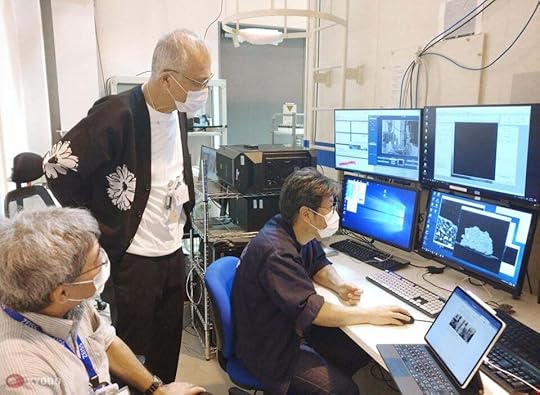
Since the Hayabusa2 returned with the sample from the Ryugu asteroid in December 2020, several important discoveries have been made – most notably analyzes confirming the presence of substances thought to be the building blocks of life on the asteroid, such as liquid water and organics fabrics.
https://newsbeezer.com/germanyeng/ryugu-asteroid-helps-unravel-the-origin-of-life-on-earth/
Hayabusa-2 took several years to land on Ryugu (literally “Dragon Palace”), pound out just over 5 grams of asteroid material, and bring it back to Earth (landing in Australia in late 2020).
NASA scientists have confirmed not just frozen water but liquid — inside crystals called pyrrhotites. JAXA scientists (pictured above with Prof Tsuchiyama of Ritsumeikan University, my main employer!) continue to check the density of the samples.
The water is similar to the carbon dioxide-laden water of hot springs. The research teams have already discovered over 20 amino acids, the basic protein building blocks of carbon-based life.
Another theory called “panspermia” proposes that a key mineral (boron) missing on early Earth came in an asteroid from Mars.  Hmm. Did Mars produce asteroids? Or more like asteroids hit Mars and broke off lots of tiny fragments? That somehow survived the journey to Earth?
Hmm. Did Mars produce asteroids? Or more like asteroids hit Mars and broke off lots of tiny fragments? That somehow survived the journey to Earth?
Seems a little unlikely. But there is now evidence that at least some proteins came from space rocks.
So, sorry, Ridley. This isn’t how it happened. Cool movie, though.

January 24, 2023
Turn off the lights, and you’ll be seeing stars!
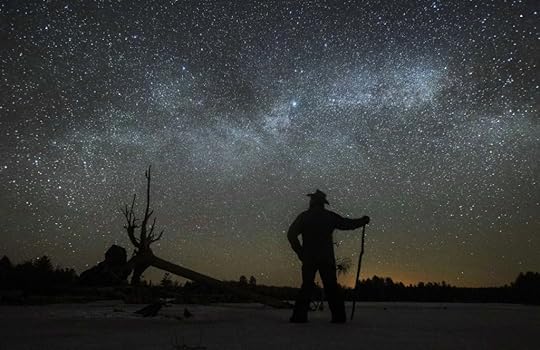
A new study that analyzes data from more than 50,000 amateur stargazers finds that artificial lighting is making the night sky about 10% brighter each year.
https://www.nbcnews.com/science/space/twinkle-twinkle-fading-stars-hiding-brighter-skies-rcna66692
Each spring in my Current Events and Global Issues class, I have students read about environmental issues.
Pollution is obviously related. But they almost never guess the “seven types of pollution” (yes, I know some people country eight, or ten, or even twelve…it all depends on how you categorize them).
They never consider Light Pollution.
Maybe it’s because most of my students (to the order of 90%) come from medium and large cities. To me, having grown up in a mostly rural area (in elementary school, my town had about 400 residents and in junior and senior high I lived in a “queen village” that had — gasp — an incredible 4,000 residents) — well, being surrounded by darkness was no big deal.
We could see stars from our backyard. Lots of stars. We learned all the major constellations (of the Northern Hemisphere, anyway, since that’s what we could see).
And more importantly we could see lightning bugs (or “fireflies” or “glowworms” or “candle bugs” etc). Decreasing water quality is thought to contribute to their declining numbers, but it’s far more likely that our insistence on lighting up the skies all the time are preventing them from finding a mate (hence the reason they “flicker” at night).
Turn off the lights!
What are you afraid of?
January 23, 2023
What is this “Cislunar” space?
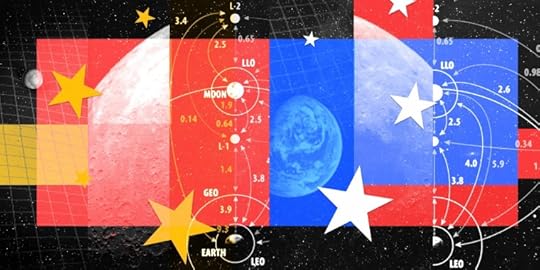
Though definitions sometimes differ, cislunar space generally refers to the space between Earth and the moon, including the moon’s surface and orbit. Any nation or entity that aims to establish a presence on the moon, or has ambitions to explore deeper into the solar system, has a vested interest in operating in cislunar space, either with communication and navigation satellites or outposts that serve as way stations between Earth and the moon.
https://www.nbcnews.com/science/space/space-earth-moon-get-little-crowded-rcna64333
There is actually a limited amount of orbital space available between the Earth and the Moon (note: capitalize it, NBC! grrr..).
So, expect more and more competition for satellites — communication, navigation, and way stations.
And of course military and spy stations.
And by the way, only eight nations signed the so-called “Artemis Accords” in 2020. Guess who didn’t?
Buckle up!
January 16, 2023
That’s what I want: A tall building with frickin’ laser beams on top!
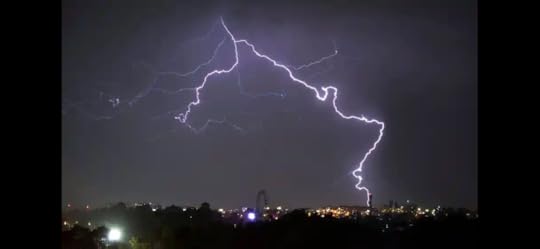
The feat, which involved firing powerful laser pulses at thunderclouds over several months last year, paves the way for laser-based lightning protection systems at airports, launchpads and tall buildings.
https://www.theguardian.com/science/2023/jan/16/scientists-steer-lightning-bolts-with-lasers-for-the-first-time
Probably a little cost-prohibitive for most of us, but potentially useful for others!

January 12, 2023
Webb finds rocky Earth-sized planet
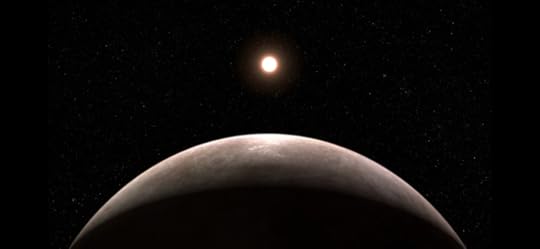
The finding demonstrates how the observatory could be used to search for potentially habitable planets in the cosmos and examine the chemical makeup of their atmospheres.
https://www.nbcnews.com/science/space/james-webb-telescope-finds-first-exoplanet-rcna65374
LHS 475b is 41 light years away, orbiting a red dwarf star in the Octans constellation (one of a few “modern” constellations only seen in the deep southern hemisphere).
Webb can even detect the presence of atmospheres, though given LHS475b has an orbit of two days and is a “few hundred degrees warmer than Earth,” it’s unlikely it’ll find much with this exoplanet.
Still, it’s a first. The first of many, I hope.
January 7, 2023
Bringer of Light, Chapter 38 (Part 1): United Mars Colonies — Cut the Tether
This installment is a bit longer than anticipated, so I will cut it into two parts. Metaphorically. Just like the Artemis crew will need to, following their agreement with the Mars colonies faction heads to train the afflicted settlers in controlling their odd new powers and sensations while assisting in distribution of temporary water and food supplies. Only Martin, the former Mars UN Overseer, who thinks he can manipulate the situation, is about to find out things are proceeding far faster than he planned. And Luna Base has a nasty surprise in store for Mars…
The storeroom chambers were nearly full by now. It had taken several days, but at last the food and water brought from Ceres had been stacked neatly, carefully portioned and labelled for each settler division. Orders were sent to each settler node requesting two or three representatives to bring their respective robotic platform dollies to the main supply chamber.
Cooper strolled casually along one earthen wall, rubbing a hand against the soil. He could feel the regolith composite materials, sense the minerals and hydrocarbon content. It would be so easy to extract and solidify what they needed, strengthen the structure. Or dig even deeper below the planet’s surface.
“Here,” Martin said, handing a pad to Cooper. “I’ve authorized the complete list of supplies brought by the Artemis. There’s my thumb verification, at the bottom.”
Cooper accepted the pad. He scrolled up to verify, nodding. “That should do it.”
“Now,” Martin said, addressing both Artemis crew members with him. “I’d like to find out what happened to my security chief, Hamels. She was outside the airlock when you dropped the ditrium on the ice cap.”
“First things first,” Enoch said. “We’d better make sure that the quantum teleportation nodes from Luna are severed.”
“Severed?”
“Yes. Completely.”
Martin turned pale. “That would seem a bit, er, final, wouldn’t it?”
Enoch grinned. “You bet. And necessary. Who knows what might come through the next time the UA turns the system on again?”
“Meaning?”
The geist spread his hands wide and made a booming sound, then laughed. The tall spacer slapped his crewmate on the shoulder, then both laughed hysterically for a moment. Martin stared at them. Cooper couldn’t help doubling over again, holding his stomach.
It was just an in-joke, Cooper thought, wiping back tears. The former Martian leader must think them completely out of their minds.
Former leader, he thought again, straightening up. For they all knew know who the new leader of the Colonies was. And she had their full support.
She’d need it. Cooper did not trust this man, this sycophantic, perpetually handwringing career politician. It was people like this that had driven his mother and him from their home country in the first place. The thought sobered him immediately.
“Hamels,” he said to Martin. “She is none of your concern.”
“What, what do you mean by that?” the smaller man huffed. “She may be injured, badly! Or worse!”
“I seriously doubt that, Overseer,” said a voice from the far entrance. Martin gaped as his security chief walked slowly into the room, flanked by two Mars Colonies Security Forces members. They stopped just inside the entrance. Hamels nodded to one. “Tell the next settler delegation they can come in. Check them for weapons before they enter.”
“Aye, sir.”
Hamels shouldered her rifle and approached the center of the storeroom. She appeared a little disheveled and dirty, but otherwise unharmed. Martin narrowed his eyes. Was it possible—?
“Yes,” she said, as if in response. “I’m afraid I have not been entirely forthright with you, Overseer.”
Martin sighed.
“Ah,” Cooper said. “Another clone?”
“Yes,” the security chief said. “Surely, Overseer, you knew that Ceres would never have agreed to let you bring back Gen here without some sort of supervision. And yet, I, too, have been afflicted. We are, after all, not infallible creatures.”
The man made no response. Just stood there, fuming, clenching and unclenching his fists. Impotent rage, Cooper thought. He felt a brief stab of sympathy, but shoved the feeling aside.
“Have you disabled the teleportation system yet?” Hamels asked the Artemis crew members. She seemed to deliberately ignore Martin.
“No, not yet,” Cooper said. “Martin, where is it?”
In response, the former Overseer sat down on a pallet of solid food stuffs and crossed his arms, staring into the distance.
“Never mind him,” Hamels said. “He’ll get over it. Follow me.”
They left the main chamber and walked through winding connected hallways from chamber to chamber. The storeroom area seemed much bigger than they had been led to believe. More UA secrets, Cooper guessed. He’d always known that the UN never really intended to protect every nation’s needs.
Then again, given how little the other countries had helped even their own citizens, he couldn’t say he blamed the UA. Which was why none of them deserved to own the Colonies any more.
“Sergeant Major,” he asked, “Are you sure it’s OK to leave Martin like that?”
Hamels shrugged. “I suppose he could try to gather support from a few dissatisfied settlers, but from what I’ve seen of their attitude toward him, he’s likely to be seen as nothing more than a mild nuisance.”
“I’m more concerned about Weng,” Enoch said. He fiddled with his new wrist comm. “The man’s a tech whiz, but if he and Martin decide to break our arrangement…”
“He wouldn’t. He and Riss are too close.”
“Are they?” Enoch pondered. “They don’t seem to have spent more than five minutes together the past three days.”
Cooper fell silent. Truth be told, he had noticed. He had also noticed Riss and Sanvi were spending nearly the entire time together, even after their training sessions with the affected settlers.
Where did that leave him again?
“We’re getting closer,” Hamels said. “Watch your step.”
The corridors had grown steadily more and more cramped, with a lower ceiling and the barest of lighting. After about half a kilometer of walking they reached a tiny doorless chamber. To Cooper it reminded him of the walk-in closet in his teenage bedroom in Colorado. Boxes stacked from ceiling to floor. Barely room to enter. The three stood outside the low doorway and peered in.
“Is this near the original landing site of the UA colony?” he asked.
“Beats me,” Enoch said. “Sergeant Major?”
The clone nodded. “Yes. The heart of the colonies. More or less.”
“So this is where we should find the teleportation node?”
She pointed. “That’s it right there.”
Cooper followed her gesture. It just looked like another stack of boxes to him. Then he saw that they seemed to form a shape, as if surrounding a scaffolding of some sort. He and Enoch looked at each other, nodded, then as if telepathically communicating, began to pick up boxes on either side of the stack and set them aside.
Hamels raised her rifle. “Be careful. Let’s hope there’s no surprises on the way from Luna.”
The corner of a console appeared. More boxes moved. Discarded electronic equipment, endless entangled wires and circuit boards. “Ancient crap, man,” Enoch said. “Wonder if there are any classic VR games here somewhere?”
“Wonder if we can reuse any of the metals and minerals in here,” Cooper replied. He sensed copper, gold, mercury. Lithium. Even cobalt.
All the right ingredients for a dangerous radioactive gift.
The last of the boxes set aside, the three stepped back. The console stood waist-high on a spindly aluminum frame. Behind it what seemed to be a hexagonal platform spread slightly crooked on the floor. A single crack snaked from the center to the right, not quite reaching the edge.
“Here,” Hamels said, tossing the rifle to Cooper. She examined the console screen. Touched two spots on either side. A thin panel slid up from the back of the console and flickered to life.
Enoch whistled. “Old school. Maika‘i loa.”
The geist briefly held the weapon, then handed it to Enoch. “Here. You have better aim than I do.”
“And you’re not allowed to be violent, anyway,” Enoch said.
Cooper nodded. The navigator accepted the weapon, turning it over in his hands. No point asking why the loonie knew that. Or why he hated being called a loonie. They were all connected now, to some degree.
Cooper stepped closer to Hamels. Over her shoulder he could see her searching through menu after submenu. “Looking for the “off” button?”
“No. The ‘reject contact’ button. Only it’s buried somewhere deep in the backup directory. Hey, you!”
Enoch stopped fiddling with the rifle. “Me?”
“Keep that trained on the pad, in case something gets sent through.”
He shrugged. “Quantum teleportation doesn’t work with living things, so I don’t see why we should b— “
A shimmering curtain slid down around the platform. It touched the edge of the pad and a buzzing noise seemed to pulse from the ceiling.
“Shit,” Hamels said, hands flying over the console. “Force shield.”
“Maybe, ah, maybe something will come through after all,” Enoch said. He backed away and trained the rifle at the force shield.
“Tell me you did that, Sergeant Major,” Cooper said.
He felt strangely calm for once. He stared at the force shield. It glimmered, half-translucent with curved diagonal stripes of quantum energy streaming up and down on all sides of the hexagonal tube. Like an endlessly recursive water fall. Continually falling in upon itself. No energy lost or gained.
Beautiful.
A small cylindrical object appeared on the pad inside the force shield. It looked like a used thermos bottle turned on its side. Quite obviously it was not.
Enoch glanced at Cooper, then Hamels. “Now?”
She shook her head. “Negative. I’ve strengthened the shield the best I can. If that’s a bomb…”
It could level the entire main colony, Cooper thought…
Next: Bringer of Light, Chapter 38 (Part 2): Cut the Tether — in which shells are configured and Compton is suppressed…

January 6, 2023
“New” rock “found” in Somalia has two (or three) “new” minerals
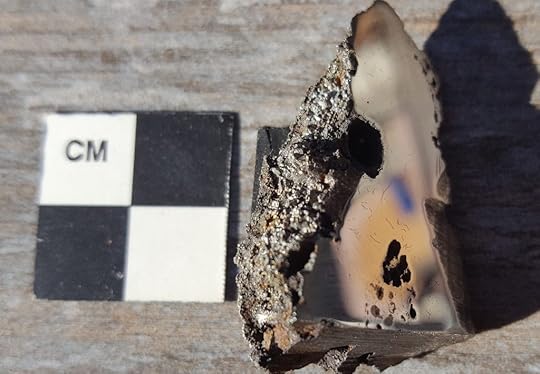
Canadian researchers said the rock was found in rural Somalia two years ago, but locals believe it is much older.
They call the stone Nightfall, and say it is documented in poems, songs and dances that stretch back five generations. It is used today to sharpen knives.
https://www.bbc.com/news/world-africa-63800879
The “new” rock is apparently a meteorite that fell to Earth at least 100 years ago (or more, depending on how you define a “generation”). The two newly-identified minerals are being called “elaliite” (after El Ali, Somalia) and “elkinstantonite” (after NASA planetary evolutionary expert Lindy Elkins-Tanton).
And there’s still one more as-yet-unidentified mineral in the 70-gram rock fragment at the U of Alberta (the original is about 15 tons, and is reported to be the 9th largest such meteorite to have survived entering the Earth’s atmosphere). These three minerals evidently do not exist naturally on Earth. Makes you wonder how many other such minerals are still floating around in space.
And of course, how they might be used to make incredibly strong yet flexible spacecraft materials. (FWIW NASA was already talking about “new” materials such as carbon nanotubes and self-healing piezoelectronic “skins” some twenty years ago…)
Now, maybe it’s just me, but I have a feeling that a 15-ton rock falling into the desert would have raised all sorts of hell. At least locally. Nothing like a 143,000 ton rock, of course. Is there really no record of this thing falling out of the sky? Maybe it’s time to talk to non-European communities and to take their oral legends a bit more seriously.



